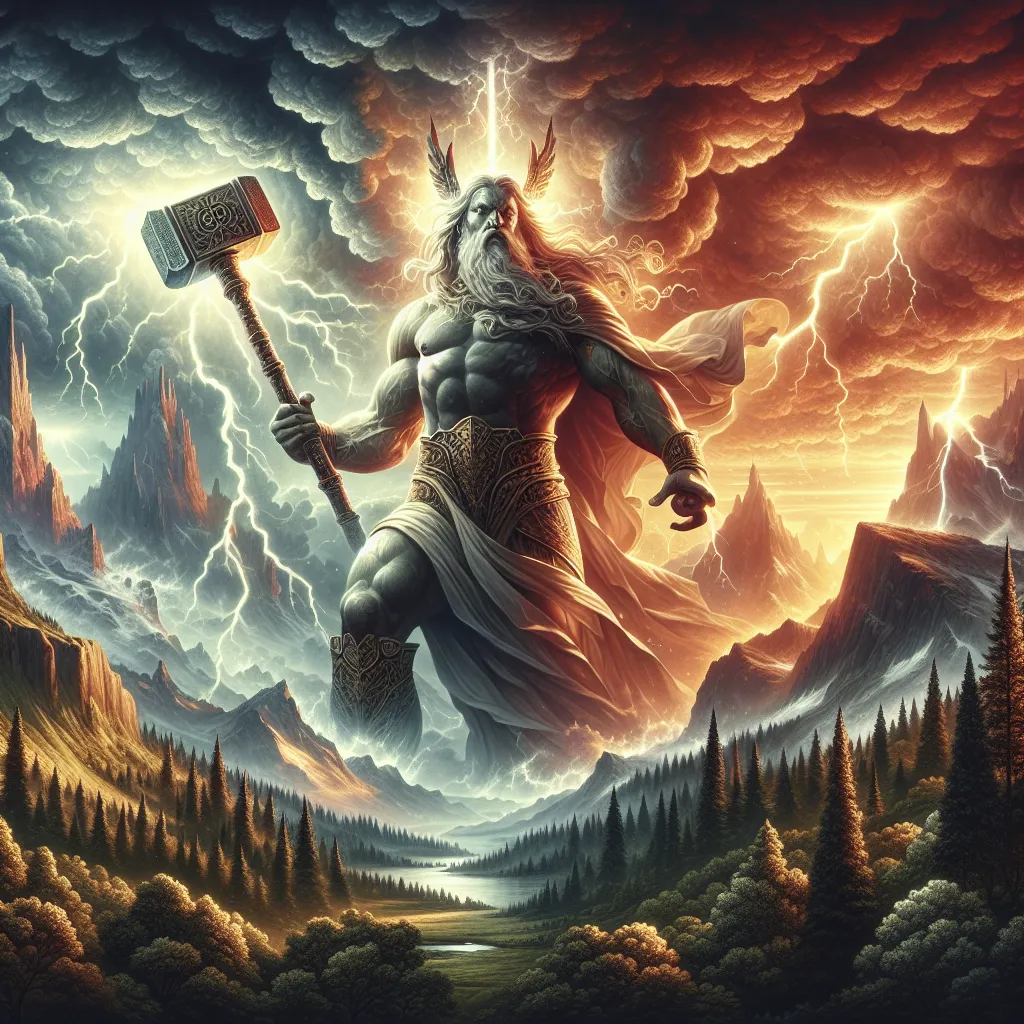
- Published on
- Authors

- Name
- You
Thor: The Thunder God and Protector of Midgard
Thor, the thunder god and protector of Midgard, holds a prominent place in Norse mythology. Often depicted wielding his powerful hammer, Mjolnir, with long red hair and a beard, Thor stands as a symbol of strength, bravery, and protection. His tales are interwoven with both mythical grandeur and deep spiritual symbolism, bridging the realms of the divine and the mortal.
The Origins of Thor
Thor is a son of Odin, the Allfather, and the earth goddess Jörð. He belongs to the Aesir, one of the principal groups of deities in Norse mythology. As a god of thunder and storms, Thor commands the skies and the forces of nature, embodying the sacred principle of destruction and creation.
Iconography and Sacred Symbols
At the center of Thor's mythos lies his weapon, Mjolnir, a hammer forged by the dwarfs Sindri and Brokkr. Mjolnir symbolizes divine power, protection, and destruction—always returning to Thor's hand after being thrown.
Symbols Associated with Thor
| Symbol | Description |
|---|---|
| Mjolnir | Thors hammer, representing power and protection. It kills foes and consecrates spaces. |
| Belt of Strength | (Megingjörð) Increases Thor's already formidable strength. |
| Iron Gloves | (Járngreipr) Necessary to handle Mjolnir, signifying preparedness and warrior prowess. |
Thor's Role and Adventures
Thor’s adventures epitomize his role as humanity's guardian. He traverses realms, combating giants (Jötnar) and other malevolent beings that threaten the order of the cosmos.
Key Myths and Legends
The Duel with Jörmungandr
One of Thor's most daunting foes is Jörmungandr, the Midgard Serpent. This colossal sea serpent, fated to grow so large it encircles the world, embodies chaos.
The Three Encounters
- Lifting the Serpent: Disguised as a cat, Thor struggles but ultimately fails to lift Jörmungandr—a divine play on the impossibility of fully overcoming chaos.
- The Fishing Trip: Thor nearly catches Jörmungandr with a bullhead for bait, foreshadowing their final battle at Ragnarok.
- Ragnarok: In this cataclysmic event, Thor and Jörmungandr face off. Thor slays the serpent, but succumbs to its venom afterwards, epitomizing the cyclic nature of life and death.
The Theft of Mjolnir
In another tale, the giant Thrym steals Mjolnir and demands Freyja’s hand in marriage for its return. Thor, dressed as Freyja, infiltrates Thrym’s realm and retrieves the hammer, symbolizing the recovery of power through cunning.
The Modern Science Connection
Modern physics offers an intriguing lens through which Thor's tales can be interpreted. Thunder and lightning—the natural phenomena commanded by Thor—can be paralleled with electromagnetic forces.
Thunder and Electromagnetism
| Concept | Mythological Interpretation | Scientific Explanation |
|---|---|---|
| Lightning | Thor's physical manifestations of power. | Discharge of static electricity in the atmosphere. |
| Thunder | Audible sign of Thor’s presence and temper. | Sound waves produced by lightning strikes. |
| Mjolnir’s Return | The hammer's repeated return mirrors cyclical natural forces. | Resonance frequencies where oscillating systems return to their initial state. |
Bridging Science and Myth
While myths transcend empirical evidence, inserting Thor within the framework of scientific understanding enhances the narrative's modern relevance.
Conclusion
Thor's enduring appeal stems from his embodiment of primal forces and protective virtues. His myths, rich with symbolic meaning, offer valuable insights into ancient worldviews and persist in the contemporary imagination through marvel comic adaptations, academic discussions, and spiritual exploration. By bridging mystical wisdom with scientific principles, Thor's tales remain both timeless and timely.
References
- Ellis Davidson, H.R. Gods and Myths of Northern Europe. Penguin Books, 1990.
- Lindow, John. Norse Mythology: A Guide to Gods, Heroes, Rituals, and Beliefs. Oxford University Press, 2001.
- Hedeägard, Claus. "Thor and The Cosmic Cataclysms," Journal of Astrophysical Inquiries, 2021.
